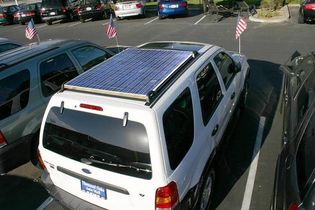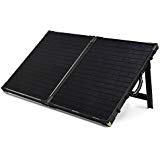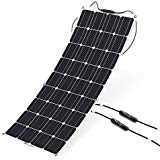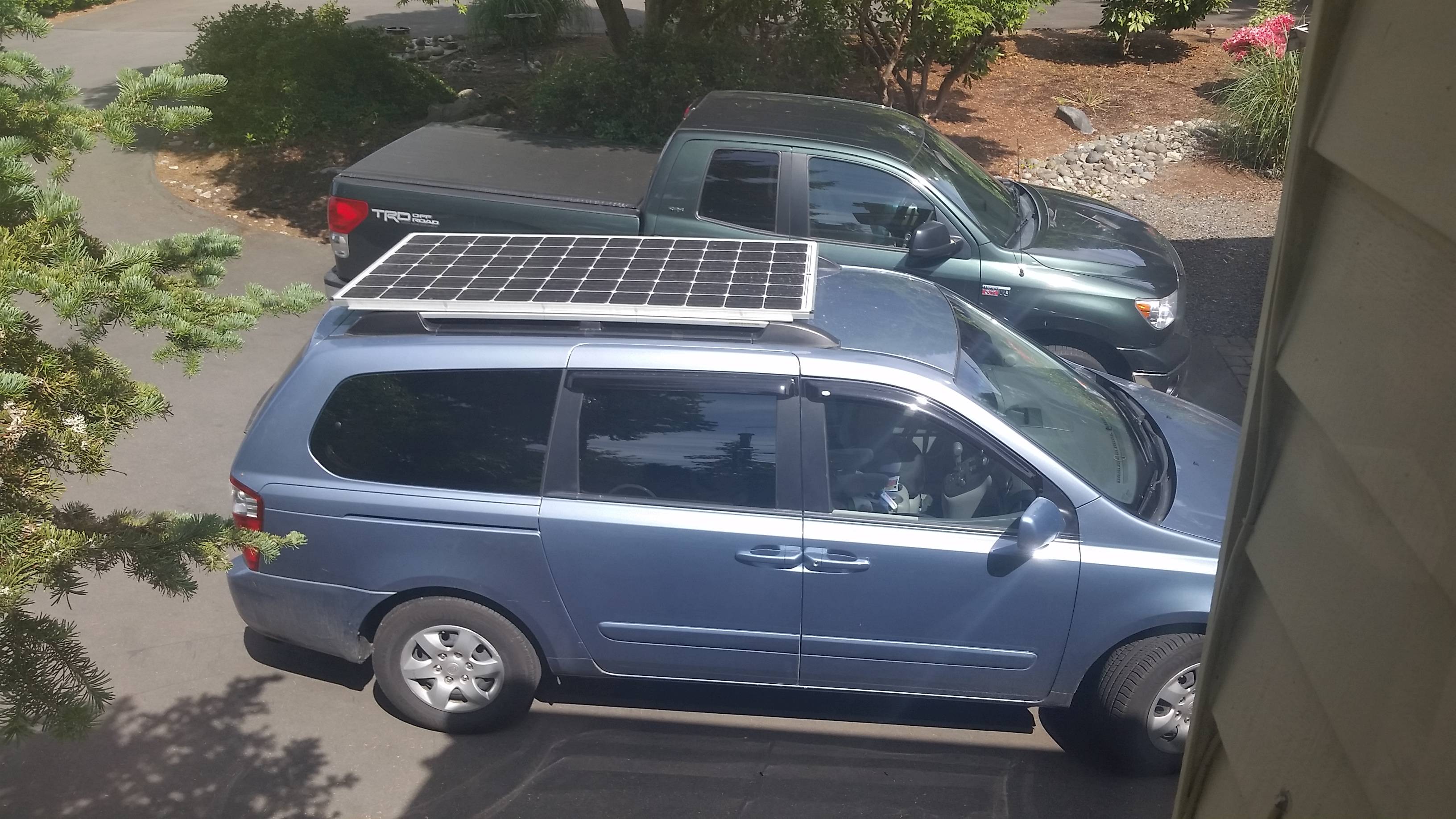Table of Contents
Resource: gentle intro to solar
Solar for car and SUV dwellers
Solar power can be extremely helpful for car dwellers, especially those living in cargo vans or other vehicles with large, high, and flat rooflines. Solar is more challenging for cardwellers due to limited roof space. SUVs are somewhere in the middle.
Framed panels can easily be hidden between the rails of a roof rack. While suboptimal, flex panels can be adhered flat on the roof. Neither are obvious to passers-by.
Example: 400w on a Sienna.
panels
rack-mounted panels
Your vehicle may already have a rack (or at least rails), making the job easier. A simple two-bar universal rack is about $150, and a nice locking two-bar rack from someone like Inno is about $300-$450.
When rack-mounting panels, mount them flush with or on top of the rack. This will prevent the rack from shading the panels.
To prevent theft the panel could be attached with tamper-proof fasteners.
 When racks are present, mounting a panel or two on them is often the first choice:
When racks are present, mounting a panel or two on them is often the first choice:
- no additional holes need to be drilled in the roof to mount the panels
- always deployed, nothing to set out
- no re-aiming, re-angling as with portable panels
- can use the least expensive and most durable (framed) panels
- the panels get some breeze under them to minimize heat-related power loss
- cable gland, low profile vent, etc, can be mounted under the panel
- less panel heat transferred into the living space
- if flush mounted between the racks it can be quite stealthy
- this one is a goof/stunt, but shows how big a panel could mount on a Subaru Tribeca
- 80w temporarily mounted on station wagon; room for at least 100w.
portable panels
Portable panels are panels that store away and are deployed as needed.
Pro: Panel can be in sun while car is in shade. Can be secured when not in use. Can be aimed at the sun.
Con: Expensive per watt. Newbies commonly underestimate how much power is required. Voltage drop from long wiring runs. Must be aimed at the sun1), which would require repositioning every couple of hours. Portability increases risk of theft. Can be urinated on by dogs.2)
Each type of portable panel has it's own strengths and weaknesses.
small framed panels
 These are the type of rigid-frame panel that folks mount on their roof, but usually smaller to keep weight and storage size down.
These are the type of rigid-frame panel that folks mount on their roof, but usually smaller to keep weight and storage size down.
Pro: Cheapest per watt. Toughest panel.
Con: Heaviest portable. Hardest to stow due to frame thickness, panel size, and rigidity.
briefcases
 Briefcases are typically 2-4 small panels hinged together. The suitcase folds up after use.
Briefcases are typically 2-4 small panels hinged together. The suitcase folds up after use.
Pro: Fold for easier storage. Built-in handle makes carrying easier.
Con: Most expensive per watt. Relatively heavy. Can be fiddly. Subject to mechanical wear from setup and teardown. Some have a built-in charge controller, resulting in very long runs between controller and battery.3)
semi-flexible panels
 Semi-flexible panels are basically the panel part of a framed panel without the frame. In the past these were usually amorphous4) cells but now it is common to see mono and, to a lesser degree, poly.
Semi-flexible panels are basically the panel part of a framed panel without the frame. In the past these were usually amorphous4) cells but now it is common to see mono and, to a lesser degree, poly.
Pro: Very light. Extremely thin, which allows it to be slid into narrow storage.
Con: Can blow away in wind. Much easier to damage than framed panels; consider the lifetime of these panels to be a few years rather than decades. Roughly 2x as expensive as framed panels.
encased panels
Low yield panels (10w-25w) encased in hard plastic. Most often seen in backpacking scenarios or on dashboard “battery maintainers”.
Pro: Small.
Con: Most expensive Watt/$. Lowest output. Can overcharge batteries that are unused.
batteries
Batteries are bulky and relatively heavy; finding a place to install the house battery bank may be the biggest power-related challenge facing cardwellers.
where to put a battery
From front to rear:
- under the hood - it is unlikely there is enough room under the hood for an aux battery, but some older full-size vehicles may allow it. Upside: convenient for alternator charging. Downside: underhood heat is inappropriate for lithium batteries.
- in the passenger area - Upside: convenience of wiring for loads. Downside: need to secure battery to protect occupants in case of accident. Takes up living space.
- in the trunk - Upside: out of the living space. May make connection to trunk- or roof-mounted solar easier. Downside: long wiring runs from alternator to battery5) mean either expensive heavy wiring or a voltage-boosting DC-DC charger.
- in a carrier rack - a secure cargo box may be fitted on a reciever hitch carrier. Upside: not taking up living or trunk space. Venting batteries are usable. Downside: same wiring issues as trunk. Cargo box may block easy access to trunk, and will increase overall vehicle length. May cause “tail dragging” on very uneven offroad surfaces
battery types
Deep cycle batteries appropriate for off-grid use are discussed in this article. There are some differences for cardwellers:
- flooded lead-acid (FLA) - difficult to have in the passenger area due to venting requirements and small interior spaces.
- “maintenance free” flooded lead-acid (MF) - Don't vent like FLA but also tend to dislike deep cycling
- “marine” flooded lead-acid - In theory they are somewhere in between FLA and MF.6) In practice it's often just a label put on by the seller, reseller, or manufacturer.
- AGM lead battery - a lead battery where the liquid electrolyte is replaced with a saturated fiberglass mat. Theoretically spillproof. Relatively $$, and love current so additional alternator charging is recommended.
- LiFePO4 lithium battery (LFP) - Drop-in LFP are no longer $1000 luxury items. Some with low-temperature protection are <$400. These are still 2x the price of AGM (and 4x the price of FLA) but if you will be in the car for years and/or will have sporadic charging then a lithium bank will pay for itself.
- non-LFP lithium battery - Non-LFP lithium batteries do exist but the bank voltage doesn't line up well with normal 12v. In addition, non-LFP lithium is known for “thermal runaway”.11)
- “solar generators” - the most expensive option per watt-hour (Wh) delivered and often very slow to charge from ciggy outlet and solar, but convenience and portability make solar generators a preferred option for some.
charge controllers
Solar panels don't connect directly to batteries. They go through a solar charge controller that coordinates the panels' production and the battery's 12) demands.
Part of the article linked above covers how to choose a controller type and what size (rating) to select.
If you have a solar generator a solar controller of some kind is built into it.
In any case, read the specs carefully to make the panels you like will work with it. The critical piece is something like maximum input voltage. If the max is 23.0v then you could use a panel with a Voc of 20v, but could not run two panels in series for 40Voc.
alternator charging
While cars tend to have smaller alternators than vans they can still be a source of significant power compared to solar. Examples:
- small DC-DC charger feeding an aux battery
example setups
The following DIY setups sketch out what off-grid power systems for cardwellers might look like. These are ideas to compare against your own use case and specific power requirements, not recipes to follow. Read the specs on each piece of gear before purchase. They are listed from most expensive to least expensive.
general principles
The alternator is the most powerful charging source available in the vehicle. The amount of power you can safely take from it depends on the alternator's current rating. The alternator can charge the battery bank through a relay (crudely, cheaply) or DC-DC charger (precisely, expensively).
100w solar panels are ~$1/watt. Used higher voltage panels are about 1/3rd of the price per watt, but require an MPPT solar charge controller and are typically >200w.
Larger battery banks don't just store more energy, they allow higher charging rates from the alternator13) without stressing the battery.
$800
This is a relatively large setup for a cardweller, but at this point we get to leverage the economies of larger batteries and used panels.
- 250w higher-voltage used panel, mounted between luggage rails, ~$80
- kisae DMT1230 30A MPPT+DC-DC, $225
- 100Ah self-heated LiTime LiFePO4 (or similar), $440
- small PSW inverter like the Bestek 300w, up to 500w would be comfortable for the battery.
Dropping to 50A LFP would decrease cost to ~$510. All numbers below would stay the ~same.14)
Actual power harvest would vary depending on the amount of driving (alternator), and location/season (solar). Let's assume 30 minutes of driving each day and middling latitudes like Salt Lake City.
performance
Solar, conditions described above
- summer (June) - ~200Wh alternator + 1,483Wh solar = 1,683Wh/day (2.10Wh/$)
- winter (December) - ~200Wh alternator + 401Wh solar = 602Wh/day
loads
- DC ~50A (650w)15)
- AC (inverter) ~40A (520w)
$650
As above, replacing the DC-DC/MPPT combo with separate relay/VSR and 20A MPPT. Solar harvest stays the same, but I'll estimate average alternator harvest drops by almost half at normal states of charge.
- summer (June) - ~130Wh alternator + 1,483Wh solar = 1,613Wh/day (2.03Wh/$)
- winter (December) - ~130Wh alternator + 401Wh solar = 531Wh/day
$480
Simplifying with PWM controllers and relays instead of DC-DC. 1/2 the battery, so ~1/2 the alternator charging. Price doesn't go down much because we are paying $1/watt retail for new panel.
- 50A LiFePO4, $160
- combiner or VSR for alternator charging - $50
- 2x 100w panel - $200
- 20A single stage PWM charger - $20
- small PSW inverter like the Bestek 300w - $60
performance
Solar, same assumptions as the above
- summer (June) - ~65Wh alternator + 488Wh solar = 1,041Wh/day (2.54Wh/$)
- winter (December) - ~65Wh alternator + 284Wh solar = 349Wh/day
loads
- DC ~25A (325w)
- AC (inverted) ~20A (260w)
$300
Half the solar brings the cost (and harvest) down:
- 50A (640Wh) LiFePO4
- combiner or VSR for alternator charging - $50
- 100w panel - $100
- 10A single stage PWM charger - $15
- small PSW inverter like the Bestek 300w - $60 and/or USB outlets
performance
Solar, Same assumptions as the above
- summer (June) - ~65Wh alternator + 488Wh solar = 553Wh/day (1.84Wh/$)
- winter (December) - ~65Wh alternator + 142Wh solar = 207Wh/day
loads
- DC ~25A (325w)
- AC (inverted) ~20A (260w)
$110
per this setup. Huge bang for buck, but available power is quite small and also limited to periods of strong sunlight.
- 100w panel - $100
- 10A single stage PWM charger - $15
performance
Solar, same assumptions as the above
- summer (June) - 488Wh solar = 488Wh/day (4.44Wh/$)
- winter (December) - 142Wh solar = 142Wh/day
loads
- DC ~10A (130w)
- no AC (inverter) loads
